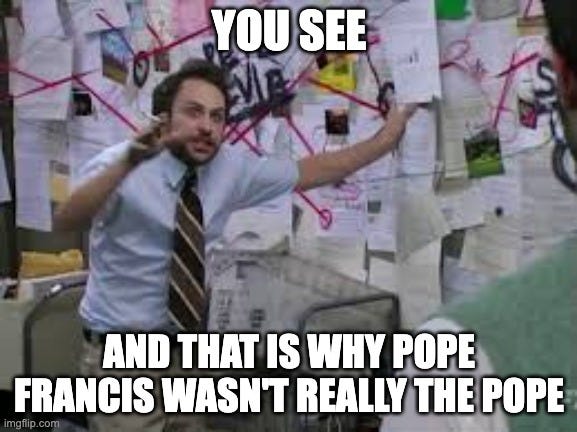Pope Francis, Pastoralism, and Purity Tests
How Purity Politics Threaten the Inclusive Church He Tried to Build
Many things have happened since the day in 2019 when I officially decided to start using the name “Max” and begin my transition. One of the first was immediate backlash: there are certain things one must not do as a “good Catholic,” and high on that list is something as subversive as a gender transition. Sure, Catholics will pay lip service to the idea that “all are welcome,” but they usually just mean they’ll tolerate the alternative kids and the nerds—as long as the theology checks out.
Except, their theology might as well be a straightjacket. “Love the sinner, hate the sin” amounts to setting a hard boundary on how much you’ll accept someone, all while preaching unconditional love toward them. Many people, it turns out, either implicitly or explicitly crave this kind of rigidity in doctrine. Already, in the wake of Pope Francis’s passing and burial this past weekend, there has been a wave of voices calling for a “non-woke Pope”—as if the white, male head of a wealthy, thousand-year-old institution has ever embodied true diversity of age, race, or experience.
That’s one of the tensions you might be holding in this moment: the fear and uncertainty about what comes next. What comes next, in this frightening and unstable moment for the world? And who has a voice, and a “valid” one, in making these decisions and voicing their opinions?
It’s the age-old resurrection of purity tests in time for Easter Octave, where Catholics around the world are debating who can mourn Pope Francis’s passing, who can have a say in his “replacement,” and who is truly Catholic in a world of increasing division.
Purity tests are sets of standards or expectations developed by political, religious, or social movements to establish an in and out group. When used to separate and associate people with one group or another, these tests rely on the no true Scotsman fallacy (shown below). As the example shows, the fallacy relies on the idea that contradiction can exist, but people will merely invalidate this contradiction as false or invalid.
Person A: "No Scotsman puts sugar on his porridge."
Person B: "But my uncle Angus is a Scotsman and he puts sugar on his porridge."
Person A: "But no true Scotsman puts sugar on his porridge."
This logical fallacy seeks to deny the purity or validity of anyone who does not reinforce set expectations or prescribed beliefs. We have encountered this as queer Catholics; our intersectional identities are often invalidated by both communities we are part of. Members of the LGBTQ+ community express confusion as to why we continue to associate with a Church that continues to deny our existence and one with a long history of colonial violence, financial exploitation, and clerical sexual abuse.
It’s a fair question, and one that we approach and explore often—continuing our work because, as we spoke about to BBC reporter Mark Lowen following Francis’s passing, queer and trans children will continue to be born into Catholic families around the world. Fostering welcome spaces is a matter of survival for the people we were and are.
On the other hand, Catholics do not understand why we would “stay” LGBTQ+ if we choose to commit ourselves to the Church--as if our identities are a choice. Often, these same Catholics argue that we are choosing individualism over collective devotion, when in reality, the idea that we can sacrifice our identities just as we would give up meat on a Friday or television for Lent is the central construct of internalized queerphobia and conversion therapy. These purity tests are impossible and impassable, and often queer and trans people raised in the Church end up leaving Catholicism, undergoing a lengthy, intense deconstruction process, or suffering in silence.
“Straightjacket theology” is an accurate description—for centuries, the Catholic Church has leveraged institutionalization, medical violence, and spiritual abuse to falsely argue that being LGBTQ+ is changeable without irreparably damaging the whole person.

Purity Culture and Purity Tests: A Deep Dive into History
Putting on Emma’s history hat for a moment: purity tests have a dangerous history rooted in the morality and race policing at the heart of the Social Purity Movements of the late 19th and early 20th centuries. These movements, as we've discussed before, sought to preserve the supposed purity of White Anglo-Saxon Protestants in the United States by policing, regulating, and restricting Black and Brown individuals, disabled people, and members of faith traditions outside of White Protestantism. At the same time, these standards turned inward, imposing ever-stricter purity tests within White Protestant communities themselves—reinforcing the idea that no one, even within the in-group, could ever be good enough.
It’s a form of morality policing that many Catholics know all too well, especially those who lived through the Purity Culture Movement of the 1990s and early 2000s or were formed by the Theology of the Body teachings during the John Paul II era. It involves the self-policing of our minds and bodies, as well as the external policing of young people's sexuality through their clothing, behaviors, and relationships. Purity tests are also weaponized—just as they were, and still are, among White Protestants—to separate "true" Catholics from others, in the same way the "No True Scotsman" fallacy operates. The goal is to reinforce the idea that some people are more holy than others—and that, because of this supposed holiness, they are entitled to mourn (or refuse to mourn) Francis’s death and to have a say in the conversations about who should next sit in St. Peter’s Chair.
Some Catholics today have chosen to criticize Christians, people of other faiths, and atheists for becoming invested in the upcoming conclave to elect the next pope--largely as a result of the political thriller of the same name that was released last year and won two Academy Awards. As of the Pope’s passing, Conclave film viewership is up over 280% and members of the public and mainstream media are providing deep dives and opinions on the real-life candidates.
In these conversations, there’s a consistent effort to disqualify and dismiss the public’s opinions, even though the choice of the next pope will deeply affect the lives of many outside the Church. Certain voices are deemed unqualified to speak—or their grief is discounted entirely—positioning them as neither credible participants in the conversation nor worthy mourners. These same purity tests are weaponized within the Church itself: practicing Catholics against lay Catholics, cradle Catholics against converts (as in this Instagram reel we found during the research for this essay), "Rad Trad" Catholics against those who attend Novus Ordo Masses or support the reforms of Vatican II. It’s all about policing who gets to mourn Francis, who gets to call themselves Catholic, and who is deemed faithful enough.
This is also the logical fallacy at the heart of many "Rad Trad" arguments against Pope Francis's legitimacy. By their definition, no true Catholic would support post-Vatican II traditions—including the Novus Ordo Mass—and therefore, even though Francis led the Catholic Church, (a Church that gathered and voted to respond to a modernizing world during the Second Wave Feminist and Civil Rights Movements of the 1960s), he cannot be considered a valid pope. The same fallacy argues that anyone who accepts a Vatican II Church is not a "real" Catholic—and thus, by their logic, Francis was illegitimate.
The Manoverse makes Manhood Unattainable
Far-right leaders have weaponized the term "purity test" to discredit any ethical challenge to the political status quo—for example when leftist figures like Elizabeth Warren and Bernie Sanders refused corporate donations and demanded higher standards. Their principled stances were reframed as evidence that the left is impossible to satisfy. Like a dog whistle—a coded way to smuggle extremist views into the mainstream (as when Catholic leaders attack "gender ideology" instead of openly targeting trans and queer people)—"purity test" becomes a rhetorical tool to dismiss serious critiques without ever addressing them. It’s a deliberate move: to turn conviction into a flaw, and to paint any real demand for justice as inherently unreasonable.
This criticism is especially hypocritical given how often far-right leaders use their own purity tests—sometimes under different names—to decide who counts as a die-hard supporter, who is loyal enough to serve in Trump’s cabinet, and who is "man or woman enough" to belong to their party (and ultimately, to humanity).
In the wake of Pope Francis’s passing, leaders like Trump and Vance, who have long used their public platforms to reinforce hypermasculinity, attempted to stake their claim as mourners. Trump’s ocean blue suit at the funeral, in stark contrast to the black suits worn by Presidents Zelensky and Macron, seemed a deliberate choice to stand out, while his refusal to engage in genuine acts of mourning reflected a broader self-interest.
Similarly, Vance, who had just been rebuked by the pope’s second in command for his use of the medieval phrase ordo amoris, tried to position himself as a mourner by posting on X after the pope’s death, but received a largely negative response from users who found him insincere and even “cringe.”
These performances by Trump and Vance, alongside their failure to show true solidarity with marginalized groups, reveals how their actions are driven more by a need to maintain power than by genuine compassion. In many ways their responses ring hollow and demonstrate a stark contrast to Pope Francis’s own model of masculinity, which was defined by humility, empathy, and service to the vulnerable.
In the broader Manoverse (to which some argue figures like Trump belong), purity tests dominate the social dynamics of the group because the performance of manhood is valued more highly than any actual masculine traits. Men are pushed to shave off their eyelashes, glorify poor hygiene, claim that men having sex with women is "gay," and equate aggression—and even outright abuse—with masculinity. The outcome of this type of thinking results in people like Bishop Barron platforming known abusers like Shia Lebouf–an issue we discussed in our substack piece No Country for Kings.
It’s a form of masculinity that not only harms others, but also ultimately destroys the men trapped inside it. In these spaces—and in trad wife communities—no one will ever be "enough." No man will ever be assertive enough, powerful enough, or cruel enough to meet the constantly shifting standard. No woman will ever be submissive enough, restrictive enough, virginal enough, or motherly enough to embody "traditional" womanhood.
Both ideals are impossible by design. They were never meant to be achievable.
The Gentle Masculinity of Pope Francis
Self-policing is the inevitable consequence of purity tests. When you’re constantly judging others as not valid—or not as valid as yourself—you eventually turn that scrutiny inward. Worshiping a standard for its own sake strips it of any real meaning. If masculinity becomes defined only by exerting power over others, it stops being about manhood at all. It becomes a self-destructive performance, feeding a hollow construct no one can ever fully embody. No one will ever be man enough.
Pope Francis rejected this type of masculinity. At the homily for his funeral on Saturday morning, Cardinal Battista said, “he was a Pope among the people, with an open heart towards everyone.” By taking the name Francis, he modelled a masculinity defined by gentleness, empathy, and emotion. As opposed to modern, hypermasculine constructions of apostles like Peter and Paul, Pope Francis became the first Franciscus--the only epitaph on his stone tomb. “Pope Francis always placed the Gospel of mercy at the centre,” Cardinal Battista said.
Pope Francis’s vision of masculinity, as articulated in his own reflection on St. Joseph (another example of a gentler masculinity than we see idealized today), emphasizes humility, service, and self-gift. In “Pope Francis on St. Joseph and Authentic Masculinity,” John Paul Manfredi writes about the way Pope Francis challenged the prevailing cultural ideal of masculinity defined by dominance and aggression, instead presenting a model grounded in gentle strength and protective care for the vulnerable. In highlighting St. Joseph’s quiet, courageous acceptance of responsibility, his dignified work, and his sacrificial fatherhood, Pope Francis calls men to embrace a masculinity that is selfless, attentive, and defined by the service of others rather than the exertion of power. This vision rejects the authoritarian masculinity that harms both men and those around them, urging a more authentic, redemptive model of manhood.
At Francis’s funeral, this concept of “placing the gospel of mercy at the centre” was never more on display than when Francis’s mortal remains were flanked by 40 individuals including some transgender people that served as a guard on the steps of St. Peter’s Basilica, preparing a final send off at the end of his funeral Mass. As the Vatican News reported, “for them, the ‘last’ of society, this time it will be a privilege to be the last. The last to say goodbye to Francis before the burial of the coffin … everyone will have a white rose in their hand. … The poor, the homeless, prisoners, transgender people, migrants will say ‘goodbye,’ but above all ‘thank you’ to a Pope who for many of them was like a ‘father.’” This final farewell was offered by members of society often seen as "the last"—the homeless, the poor, transgender individuals—highlighted the Pope’s legacy of inclusion and mercy.
Challenging Impossible Standards with Radical Inclusion
Pope Francis was a man who spoke through his actions with marginalized communities. The behavior of men like Trump and Vance regarding the Pope’s funeral and beyond only further illustrate the distance between their vision of manhood and the vision Pope Francis embodied.
This contrast speaks to a broader truth about purity tests: they are a tool for maintaining an artificial, destructive vision of what it means to be a "real" man or a "real" Catholic. By creating rigid categories that separate the "in" group from the "out" group, these tests limit our capacity for empathy, understanding, and transformation. They encourage a kind of self-policing that damages both the individual and the community at large. What we see in the far-right’s embrace of purity tests is not just a political maneuver—it’s a deliberate attempt to define manhood in ways that are ultimately self-destructive. It strips away the possibility of growth, vulnerability, and healing–and Pope Francis was completely against this way of treating people.
Pope Francis was a man who spoke through his actions with marginalized communities. Whether it was his unwavering support for refugees and migrants, his embrace of LGBTQ+ individuals, or his continual outreach to the poor and forgotten, he demonstrated a radically inclusive love that defied the purity tests so often weaponized by those in power. His actions were not symbolic gestures, but a profound embodiment of his mission to place the Gospel of mercy at the center of everything he did.
As the Church now faces the important task of electing the next pope, it is crucial that the Cardinals look to the example Pope Francis has set. The next pope should be one who upholds the values of mercy, humility, and service, especially to those on the margins. Rather than adhering to rigid purity tests that seek to define who is worthy of God's love, we must embrace a more inclusive and compassionate vision of the Church.
If we are to truly honor the legacy of Pope Francis, we must call for a Church that continues to break down barriers, that welcomes the stranger, that embraces the vulnerable, and that fosters a vision of manhood and humanity that is gentle, protective, and self-giving. The challenge now lies with us, the faithful and the world at large, to push back against the corrosive power of purity tests. Even if we are not the ones casting ballots in the conclave to elect the next pope, we can carry forward the work of building a Church—and a world—that refuses to measure worthiness by impossible standards, and instead welcomes all with open arms.
To support this writing, consider a paid subscription to this Substack, or a one-time tip (via credit card, cashapp, apple pay, and more) at https://ko-fi.com/maxwellkuzma. Please donate to support this work!








